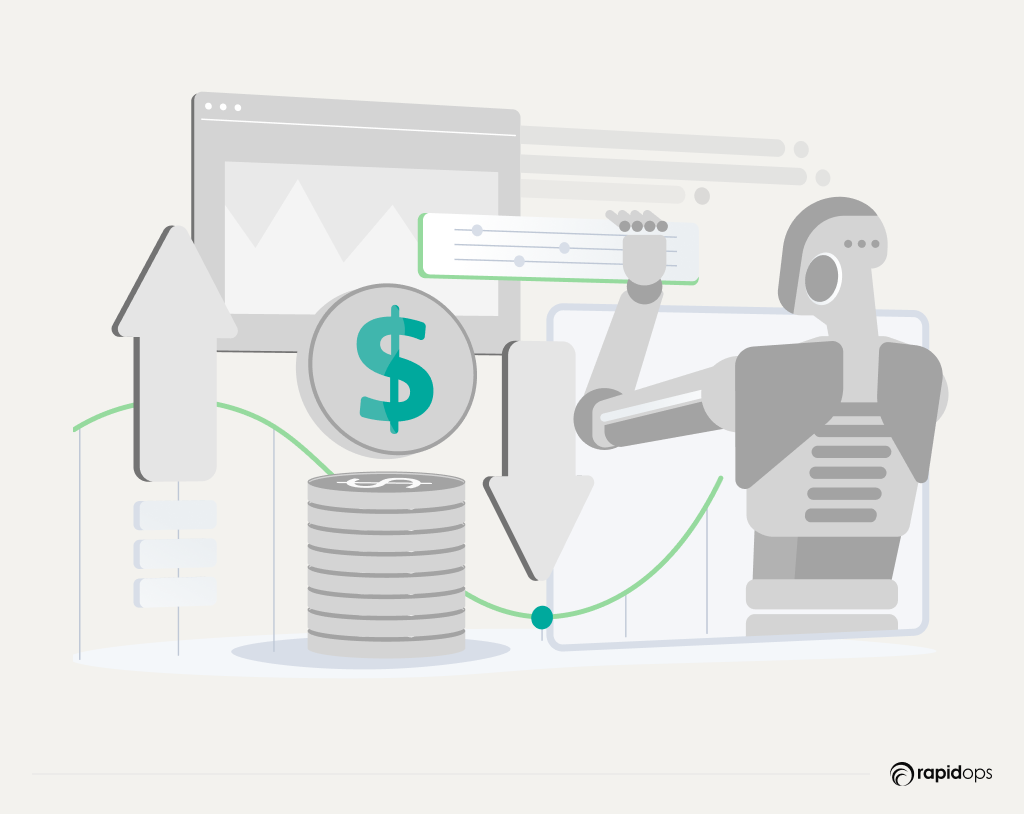In 2025, AI is no longer a disruptive force on the horizon; it’s the engine quietly powering the next chapter of retail. From online storefronts to last-mile logistics, AI has become deeply embedded in the retail value chain, enabling smarter decisions, hyper-personalized engagement, and operational precision at a scale and speed that legacy systems could never match.
Imagine this: a returning customer visits your eCommerce site. Instantly, AI recognizes not just who they are, but where they left off, what they’re likely to want next, and how to guide them toward purchase with real-time product recommendations, optimized pricing, and seamless checkout, all personalized to their behavior, preferences, and current context. That level of intelligent interaction isn’t a vision for tomorrow. It’s how leading retailers are operating today.
This isn’t just about automation or efficiency, it’s about transformation. AI has shifted from experimental pilots to a strategic foundation that’s reshaping how retailers compete in the face of economic uncertainty, shifting demand cycles, and rising customer expectations. It enables enterprises to modernize inventory management, optimize merchandising, enhance marketing ROI, and deliver consistent omnichannel experiences across both online and in-store channels.
This blog breaks down the 10 most high-impact AI use cases in retail that are already delivering measurable business outcomes. Each use case demonstrates how AI, when deeply integrated into retail strategy, operations, and customer experience, drives proven results across the retail sector.
What AI in retail looks like in 2025
In 2025, AI will redefine the online retail experience from the moment a customer lands on a digital storefront to the instant their order is fulfilled. No longer limited to product recommendations or basic automation, AI now orchestrates the entire eCommerce journey in real time.
It predicts what shoppers want before they search, adapts pricing based on behavior and demand, personalizes content by context, and synchronizes fulfillment with customer expectations. Every interaction is guided by intelligence. For leading retailers, AI isn't an add-on to online commerce; it's the operating system powering its speed, relevance, and scalability.
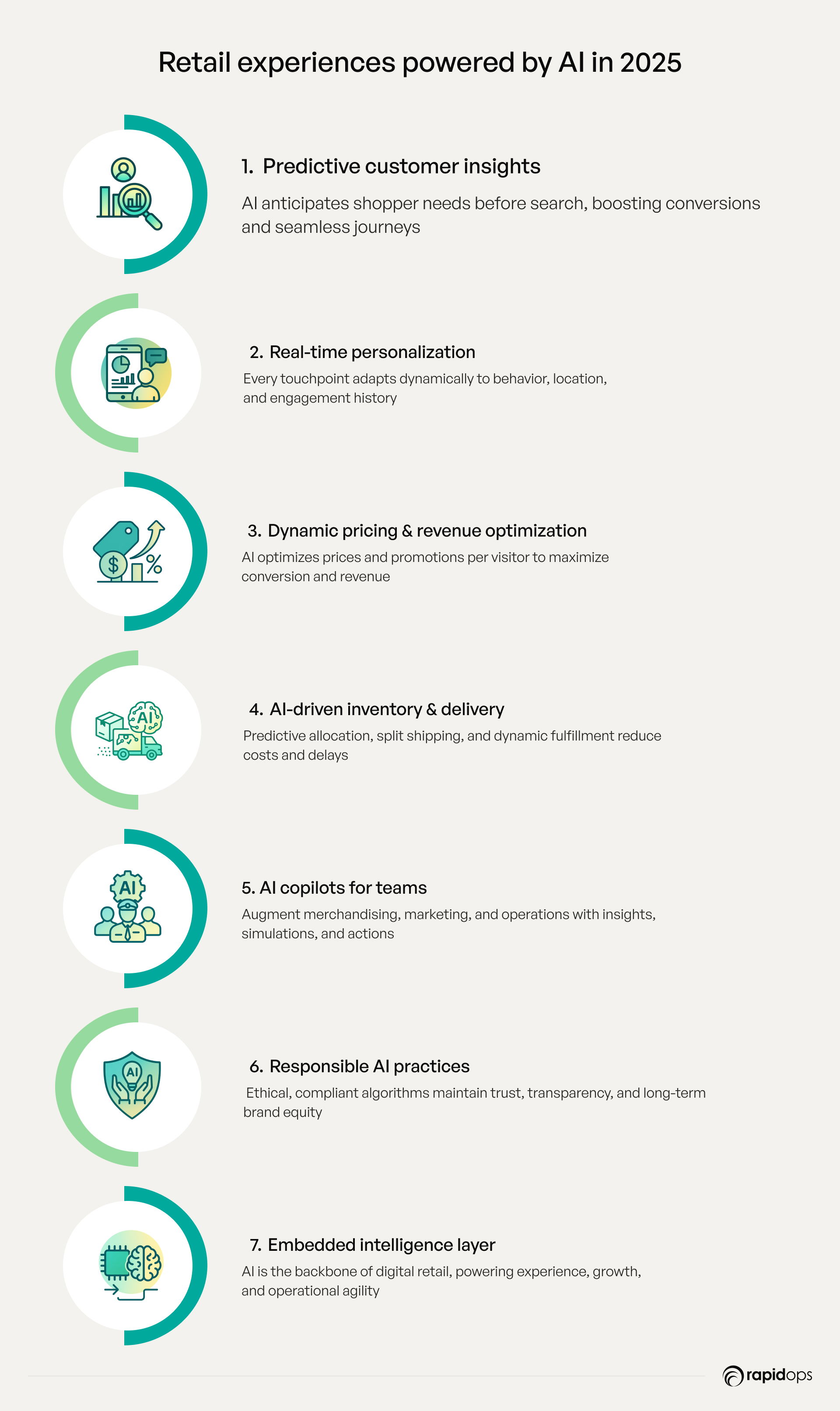
1. AI knows what customers want before they even ask
The new standard in eCommerce is anticipatory intelligence. Advanced AI models now analyze a wide spectrum of intent signals, clickstream behavior, device type, time of day, past transactions, and cohort behavior to predict what a shopper needs before they perform a search or apply a filter.
A returning customer who recently viewed sports shoes may be shown a curated collection of accessories, weather-aligned products based on their location, and an offer tied to their loyalty profile, all within milliseconds of landing on the homepage.
This shift to predictive, searchless shopping accelerates conversions, reduces bounce rates, and creates a seamless digital journey that feels intuitive and personal, even though it's powered by sophisticated algorithms running quietly in the background.
2. Every digital touchpoint is personalized in real time
From the homepage banner to the final checkout screen, AI dynamically reconfigures content, offers, messaging, and product rankings based on real-time context. This includes behavioral data, regional preferences, inventory availability, weather patterns, and engagement history.
A first-time visitor from a coastal city might see swimwear paired with beach accessories, while a frequent buyer from a colder region sees insulated apparel with cross-sell recommendations based on past cart activity.
AI-powered modules drive:
- Personalized product discovery
- Conversational commerce and voice-enabled search
- Dynamic bundling and A/B-tested layouts
- AI-generated copy tailored to user profiles
This hyper-personalization at scale helps drive not only immediate purchases but also long-term brand affinity, replacing static, one-size-fits-all storefronts with context-aware experiences that evolve in real time.
3. Pricing and promotions are dynamically optimized
In 2025, pricing is no longer a fixed variable; it is a fluid, intelligence-driven lever for conversion and profitability. AI pricing engines ingest live data from competitive pricing feeds, stock levels, time-based demand curves, and behavioral profiles to determine optimal prices for each visitor in context.
For instance, a high-intent shopper may receive an urgency-based incentive, while a price-sensitive browser might trigger a temporary discount tailored to increase conversion probability.
Retailers deploy AI to:
- Run intelligent markdown simulations
- Personalize promotions by region, behavior, or device
- Adjust pricing based on elasticity and inventory exposure
- Manage margin across product lifecycles with precision
This precision pricing model increases revenue per visitor, accelerates sell-through, and maintains profitability without relying on blanket discounts or mass markdowns.
4. Inventory, fulfillment, and delivery are AI-orchestrated
AI doesn't just enhance the front-end; it redefines operational agility across the entire digital commerce engine. From predicting demand at the SKU and regional levels to rerouting fulfillment in real-time, AI ensures that what the customer sees on the screen is aligned with real-world supply chain constraints and opportunities.
Key capabilities include:
- Predictive allocation of inventory based on sales velocity
- Dynamic delivery promises are calculated by proximity, courier load, and inventory depth
- Real-time back-in-stock notifications aligned with recommender systems
- Automated split shipping and ship-from-store logic to reduce delivery time
The result: retailers fulfill faster, minimize out-of-stocks, reduce operational costs, and consistently meet the promises made to digital customers.
5. AI copilots empower eCommerce and merchandising teams
Modern retail teams are no longer relying solely on dashboards or batch analytics. They are working alongside AI copilots that surface insights, simulate outcomes, and recommend actions in real-time, enabling faster and more confident decision-making across merchandising, marketing, and digital operations.
AI copilots help business users:
- Forecast demand shifts by region or demographic
- Simulate the impact of pricing changes or promotions on margin and conversion
- Test and auto-deploy website layout variations optimized for target segments
- Detect anomalies in shopper behavior or inventory performance
This decision intelligence layer turns AI from a backend capability into a strategic partner, augmenting human judgment, accelerating experimentation, and reducing time-to-decision across critical workflows.
6. Responsible AI safeguards trust and brand equity
With AI touching every aspect of the customer journey, governance, transparency, and compliance have become strategic imperatives. Retailers are implementing enterprise-grade responsible AI frameworks to ensure that algorithms behave ethically, comply with regulations, and maintain customer trust.
Key operational guardrails include:
- Bias detection and mitigation in recommender systems
- Transparent personalization logic that customers can opt into
- Consent-based data usage aligned with GDPR, CPRA, and region-specific laws
- Audit trails and explainability protocols for model behavior
Responsible AI isn't just about legal compliance; it's about long-term trust. Retailers who bake responsibility into every layer of their AI strategy protect both their customers and their competitive standing in a trust-driven economy.
From initiative to infrastructure
What once lived in innovation labs or pilot programs has now become the operating fabric of digital retail. In 2025, AI is no longer a siloed capability; it is an embedded intelligence layer that touches every customer journey, every product decision, and every operational function.
For retailers that lead, AI is not a bolt-on feature or experimental tool. It is the infrastructure of growth, experience, and agility.
Core technologies powering AI in retail
As AI use cases in retail scale from experimentation to enterprise-wide transformation, success increasingly depends on a robust technological foundation. From hyper-personalization and predictive inventory to real-time customer engagement and autonomous operations, each innovation is built upon a constellation of core technologies. For mid-to-large-scale B2C enterprises, particularly in sectors such as retail, manufacturing, logistics, and healthcare, understanding these building blocks is crucial for translating AI investments into tangible business outcomes.
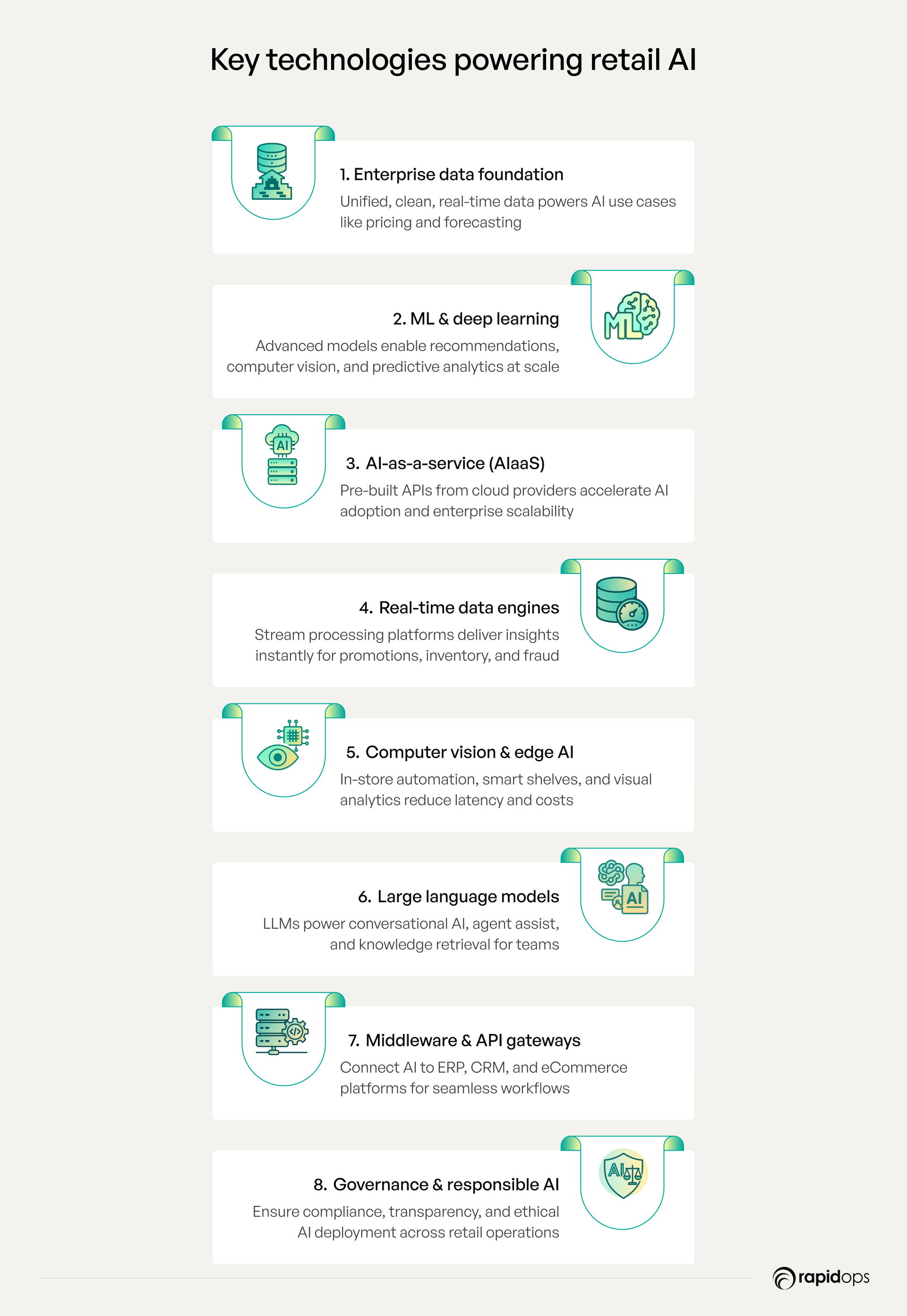
1. Enterprise data infrastructure
AI-driven retail systems require clean, connected, and continuously updated data. Modern data architectures, including cloud-native data lakes and warehouses like Snowflake, Amazon Redshift, and Google BigQuery, enable real-time ingestion and analytics at scale.
These systems unify structured and unstructured data from POS systems, customer interactions, supply chains, and inventory platforms, providing the foundation for AI use cases like dynamic pricing, fraud detection, and demand forecasting. The ability to scale horizontally across markets and channels makes this infrastructure essential to operational agility and speed-to-insight.
2. Machine Learning & deep learning frameworks
Retail's most transformative AI applications, such as recommendation engines, computer vision for shelf monitoring, or predictive churn analytics, are powered by advanced ML and deep learning models. Platforms like TensorFlow, PyTorch, and Vertex AI enable data scientists to build domain-specific models tailored to enterprise contexts. These frameworks support use cases that require high accuracy at scale, including sentiment analysis in customer service, visual search in eCommerce, and autonomous checkout in stores. Their strategic value lies not only in intelligence but also in their adaptability to changing consumer patterns and operational complexities.
3. AI-as-a-service (AIaaS) platforms
To operationalize AI across hundreds of stores or digital touchpoints, enterprises are increasingly relying on AI-as-a-Service (AIaaS) offerings from hyperscalers such as AWS, Google Cloud, and Azure. These platforms offer pre-trained APIs for natural language processing, image recognition, anomaly detection, and more, enabling retailers to fast-track time-to-value without building every model from scratch. This is particularly critical for high-volume scenarios like automated customer support or personalization at scale, where responsiveness and consistency are paramount. AIaaS democratizes access to advanced AI while maintaining enterprise-grade scalability and compliance.
4. Real-time data processing engines
Retail environments require immediate decision-making, whether it's triggering low-inventory alerts, adapting promotions based on foot traffic, or optimizing fulfillment logistics. Real-time data platforms such as Apache Kafka, Apache Flink, and AWS Kinesis empower businesses to process streaming data with low latency. These technologies support event-driven architectures that power real-time recommendation systems, fraud prevention in digital payments, and smart IoT-enabled stores. They ensure that insights are not just accurate, but delivered in the moment they matter most.
5. Computer vision and edge AI
Computer vision technologies combined with Edge AI are redefining in-store intelligence. Solutions like smart shelves, automated checkout, planogram compliance, and visual analytics rely on deep learning models deployed close to the data source, often within the store itself. Powered by NVIDIA Jetson or Intel OpenVINO, Edge AI minimizes latency and bandwidth dependence while enhancing operational efficiency. For sectors like grocery, fashion, and convenience retail, this unlocks new levels of automation, shrinkage control, and shopper behavior analytics.
6. Large language models (LLMs)
LLMs such as OpenAI's GPT, Google's Gemini, and Meta's LLaMA are unlocking new possibilities in natural language understanding and generation across retail operations. From conversational AI in customer service to agent-assist tools for sales associates and internal knowledge retrieval for merchandising teams, LLMs are reshaping how retail organizations communicate and operate. The ability to contextualize queries, synthesize information, and drive intelligent actions makes LLMs development a strategic layer for augmenting workforce productivity and improving customer experiences.
7. Integration middleware and API gateways
AI in retail does not exist in isolation. It must integrate seamlessly with ERP systems, CRMs, eCommerce platforms, inventory management, and logistics. Middleware technologies and API gateways, such as MuleSoft, Azure API Management, or Apigee, enable this connectivity, ensuring that AI applications can consume and contribute to business workflows in real-time. This orchestration layer is crucial for delivering unified commerce experiences, ensuring omnichannel alignment, and enabling data-driven decision-making across the entire value chain.
8. Governance, security, and responsible AI tooling
As AI becomes embedded in business-critical processes, the responsible deployment of AI becomes non-negotiable. Tools for data governance, model interpretability, privacy-preserving AI, and compliance monitoring are essential to ensure transparency, auditability, and alignment with ethical standards. Platforms like IBM Watson OpenScale, Google Model Garden, and AWS SageMaker Clarify help enterprises monitor AI performance, detect bias, and enforce regulatory adherence across jurisdictions. For retailers operating in multiple markets, this is a core pillar of sustainable AI adoption.
In summary, the success of AI use cases in retail hinges not on isolated algorithms but on a well-integrated ecosystem of technologies, each playing a specific role in turning raw data into intelligent, actionable outcomes. For enterprise leaders, aligning these core technologies with strategic goals, operational constraints, and customer expectations is what differentiates incremental improvement from market-leading innovation.
How retailers are creating tangible business value with AI
Artificial intelligence is no longer a future-facing ambition in retail; it’s a present-day business enabler driving measurable impact across revenue, operations, and customer experience. Today's leading AI use cases in retail are closely aligned with strategic imperatives, including margin expansion, enhancing customer lifetime value, improving operational agility, and driving data-driven decision-making. For mid-to-large-scale B2C retailers, the conversation has shifted from experimentation to enterprise-wide value realization, where the success of AI is defined by business outcomes, not proof-of-concepts.
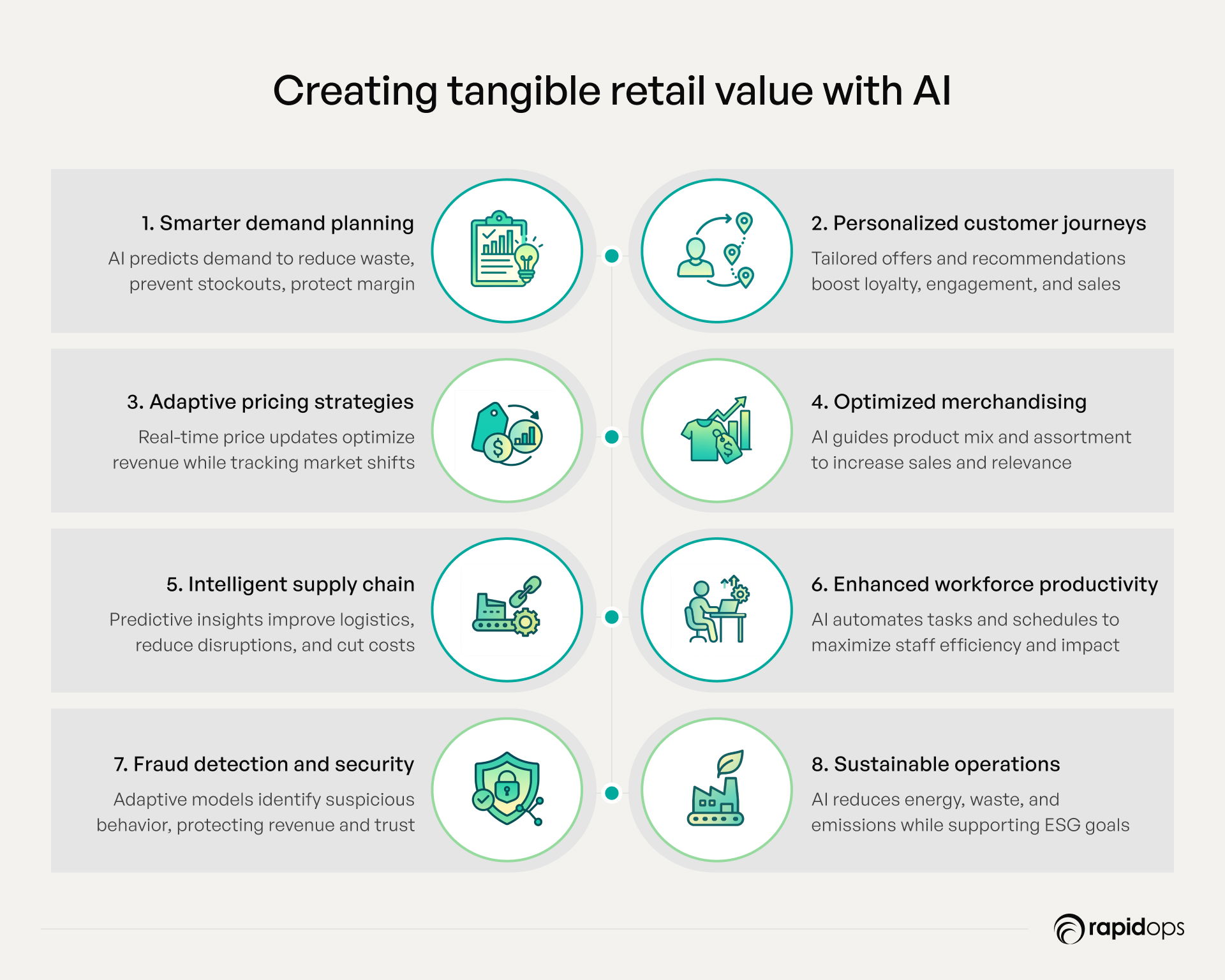
1. Precision demand forecasting to improve profitability and reduce waste
Retailers are turning to AI-powered forecasting models that learn from historical trends, real-time market signals, and external disruptors, such as weather or local events. These models adapt dynamically to new data, enabling more accurate inventory planning across locations and SKUs. The result: fewer stockouts, reduced overstocking, and lower markdown losses, all of which directly protect margins. For large retail networks, this creates significant cost savings while also improving availability and customer satisfaction.
2. Hyper-personalized customer experiences that drive lifetime value
AI enables individualized interactions across digital and physical channels. By analyzing behavioral data, preferences, and purchase history, AI systems can tailor product recommendations, content, offers, and experiences in real-time. This not only boosts conversion and average order value, but also deepens loyalty, especially in categories such as fashion, grocery, and beauty, where preferences are dynamic and differentiation is driven by experience.
3. Dynamic pricing and revenue optimization
AI pricing engines utilize real-time inputs, demand shifts, competitor activity, and inventory data to fine-tune prices at the SKU, location, and customer segment levels. These models continually learn and adjust, enabling retailers to maximize revenue without compromising brand trust or profitability. In highly competitive verticals such as electronics and home goods, dynamic pricing has become a key strategic lever for driving revenue growth.
4. AI-powered merchandising and assortment planning
AI helps retailers move beyond intuition-driven merchandising by analyzing customer behavior, purchase patterns, and regional preferences. It enables optimal product mix decisions by location and channel, increasing localized relevance and sell-through. For omnichannel retailers, this ensures assortment consistency across touchpoints driving higher engagement and sales per square foot both online and in-store.
5. Intelligent supply chain optimization
Supply chains have become critical to retail competitiveness, and AI is making them smarter. Through predictive analytics, intelligent reordering, and supplier risk modeling, AI improves lead times, reduces disruptions, and optimizes logistics. Retailers can respond more quickly to demand shifts, proactively rebalance inventory, and lower costs, especially in high-turnover sectors such as grocery, apparel, and electronics.
6. Workforce productivity and operational efficiency
AI enhances store operations through intelligent scheduling, task automation, and predictive labor planning. This ensures the right number of associates are deployed when and where they’re needed, minimizing inefficiencies while improving productivity. AI assistants also support frontline teams with insights on restocking, customer inquiries, and real-time recommendations, freeing up staff for high-impact customer interactions.
7. Fraud prevention and loss mitigation at scale
Retailers are using AI to combat fraud with real-time, adaptive models that detect suspicious patterns across transactions, returns, and account activity. Unlike static rule-based systems, AI evolves continuously to recognize new fraud tactics, reducing shrinkage and safeguarding trust. In today’s omnichannel landscape, this type of loss prevention is crucial for both financial stability and customer satisfaction.
8. AI-driven sustainability optimization
AI is enabling retailers to align environmental responsibility with operational performance. From energy-efficient store management to demand-driven logistics and waste reduction, AI helps cut costs while meeting ESG expectations. As regulatory and consumer pressures around sustainability intensify, AI is emerging as a key enabler of responsible, future-ready retail.
From experimentation to enterprise value
The value of AI in retail is no longer theoretical. Leading retailers are already driving tangible outcomes from boosting margins and productivity to enhancing loyalty and resilience. These AI use cases aren’t just technological wins, they’re business imperatives. For enterprise leaders, the priority now is clear: scale what’s working, unlock new efficiencies, and embed AI across the value chain to compete and grow smarter in a dynamic retail landscape.
Top 10 AI use cases transforming retail in 2025
AI now drives how retail leaders respond, price, scale, and serve. These 10 use cases solve specific, high-stakes challenges that demand shifts, margin compression, workforce agility, and content velocity. In an environment where execution defines advantage, these are the AI levers delivering measurable impact now.
1. AI-powered product discovery

AI-powered product discovery is transforming how customers find products online and in-store. By analyzing customer intent, preferences, and browsing behavior in real-time, intelligent discovery engines surface the most relevant items, thereby reducing friction in the shopping journey. These systems integrate NLP, visual search, and recommendation algorithms to help shoppers quickly locate what they need, even with vague or voice-based queries. For retailers, this improves conversion rates and customer satisfaction while reducing bounce rates. AI ensures the product discovery experience is personalized, responsive, and predictive, driving deeper engagement across digital and physical touchpoints.
2. Product recommendation
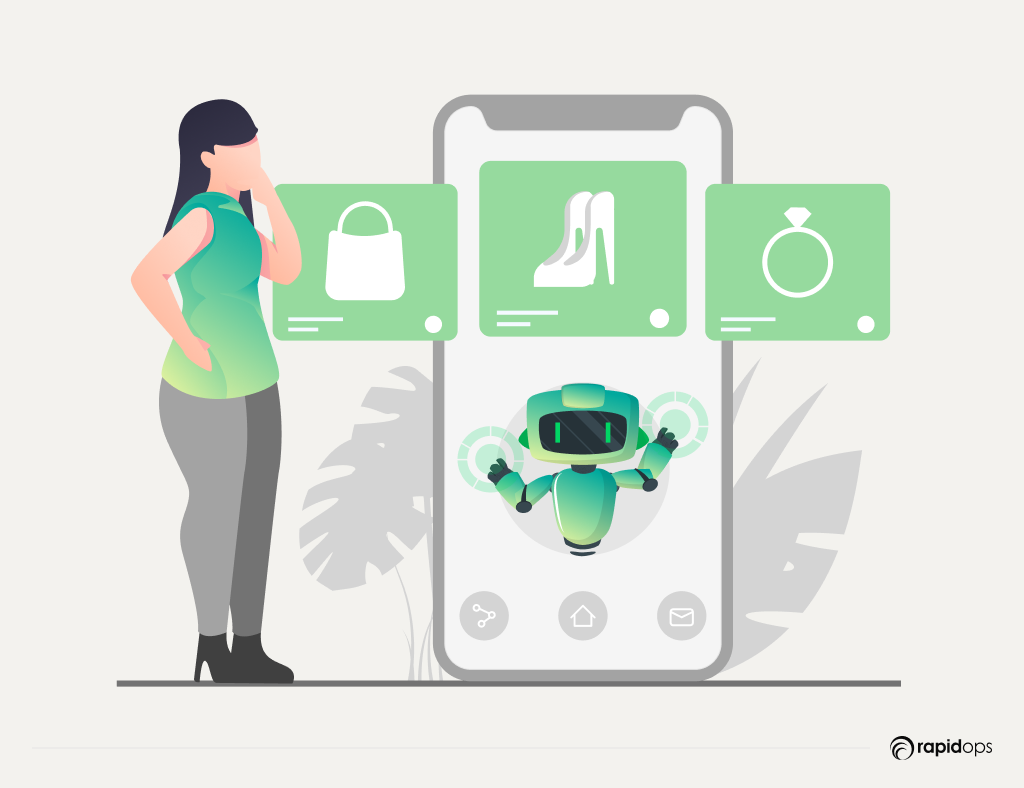
AI-driven product recommendation engines analyze vast datasets, including purchase history, contextual behavior, demographics, and current session data, to deliver highly personalized suggestions in real-time. These dynamic systems enhance cross-sell and upsell opportunities by understanding both the individual customer and broader trends. From homepages to checkout flows, AI ensures that recommendations evolve in line with customer preferences, thereby improving AOV (average order value) and customer lifetime value. Retailers leveraging AI recommendations experience higher engagement, lower cart abandonment, and increased sales velocity, especially when recommendations are integrated seamlessly across web, mobile, email, and in-store channels.
3. AI-powered up-selling

AI-powered up-selling uses predictive models to recommend premium alternatives or complementary higher-value items based on customer behavior, preferences, and price sensitivity. These models optimize timing and placement, whether during browsing, in-cart, or post-purchase follow-up, ensuring contextual relevance and maximizing conversion. Retailers can apply real-time signals, such as browsing depth, past spending patterns, or loyalty tier, to trigger intelligent up-sell offers. AI continually refines the strategy, improving ROI and sales margins while maintaining customer trust. When executed well, AI-driven up-selling not only increases revenue but also enhances the shopper’s experience with more value-aligned suggestions.
4. Conversational AI for customer engagement

Conversational AI enables retailers to deliver 24/7, human-like interactions across chat, voice, and messaging platforms. These AI-powered assistants handle inquiries, product searches, returns, and personalized recommendations with a deep understanding of context. By utilizing natural language processing (NLP) and sentiment analysis, they dynamically adjust tone and content in real-time to deliver a helpful, frictionless service. Beyond reactive support, advanced conversational agents can proactively engage users, re-engage abandoned carts, and guide discovery. This drives higher satisfaction, reduces operational costs, and ensures consistency across digital and physical touchpoints, improving overall brand loyalty and customer retention.
5. Generative AI for product content automation
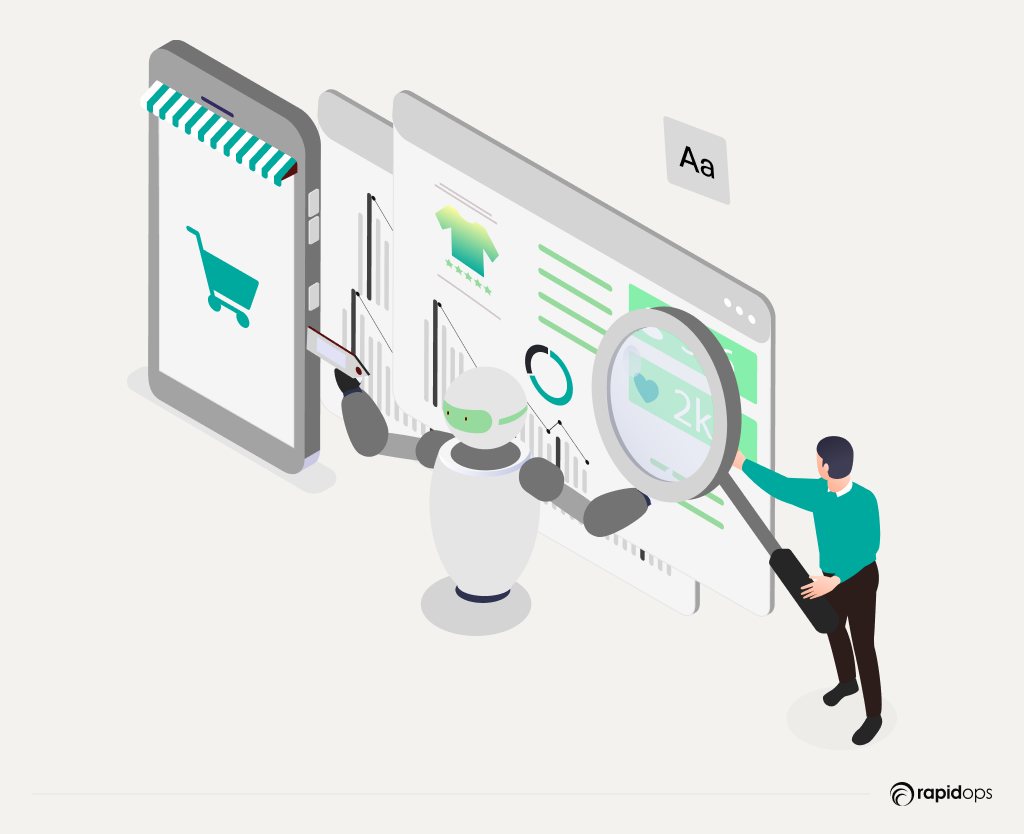
Generative AI accelerates the creation of rich, SEO-friendly product content, including titles, descriptions, specifications, and marketing copy, by transforming structured product data into compelling narratives at scale. Retailers can localize and personalize content for different audiences, languages, or channels, reducing time-to-market and manual overhead. AI ensures consistency, brand voice, and relevance while optimizing for discoverability across search engines and marketplaces. Whether launching a new collection or updating legacy catalogs, generative AI enables retailers to keep product content fresh, engaging, and conversion-optimized, critical for omnichannel success in today’s competitive digital retail landscape.
6. Real-time sentiment and experience intelligence
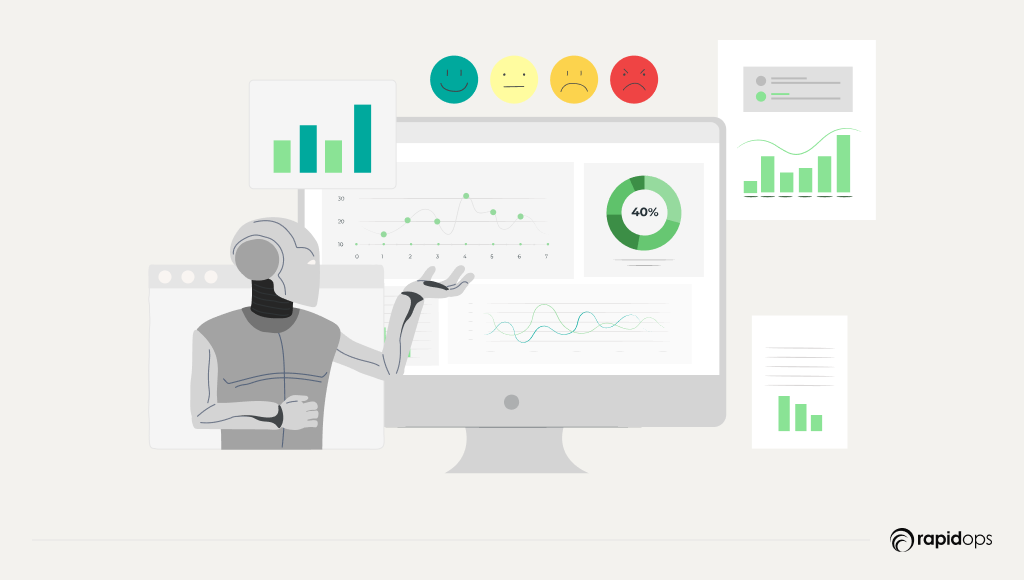
AI-driven sentiment analysis offers real-time insights into how customers feel across various touchpoints, including social media, reviews, customer service chats, and survey feedback. Natural language understanding (NLU) models classify sentiment, detect intent, and surface emerging issues or opportunities. Retailers use these insights to fine-tune messaging, improve products, and proactively resolve dissatisfaction. Combined with journey analytics, AI enables retailers to identify experience gaps, trends, and emotional triggers that influence buying behavior. This intelligence supports a more agile, customer-centric approach to engagement, driving loyalty, brand equity, and continuous improvement of the customer experience across the entire retail value chain.
7. AI-powered demand forecasting
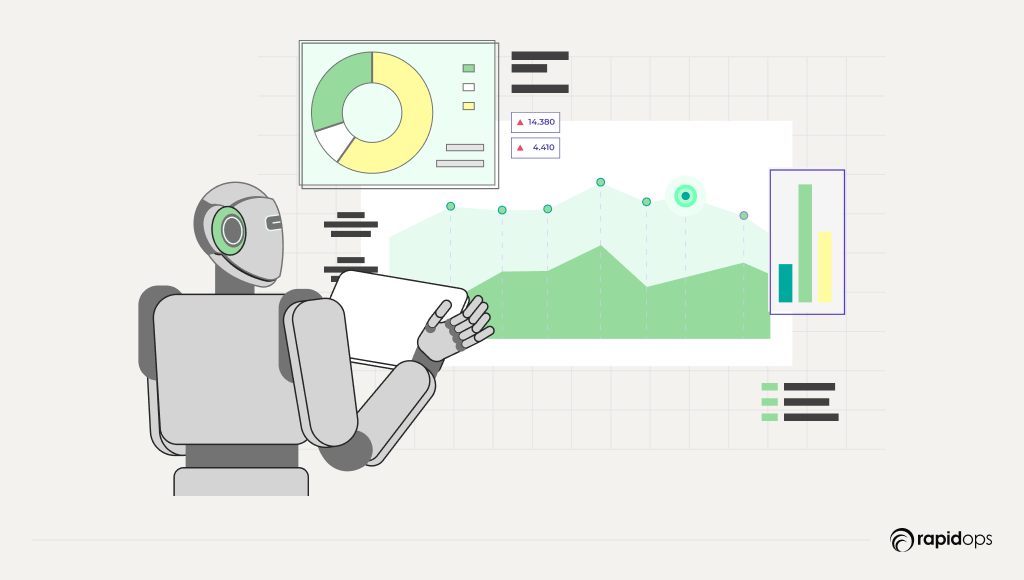
AI-powered demand forecasting replaces static, historical models with adaptive systems that account for real-time variables, such as market trends, weather, promotions, macroeconomic data, and behavioral shifts. By applying machine learning, retailers can predict demand with greater accuracy across various regions, categories, and time frames. These forecasts inform procurement, pricing, staffing, and inventory decisions, reducing overstock and stockouts. AI continuously refines models as new data flows in, enabling responsive planning during peak seasons, disruptions, or product launches. Retailers leveraging AI forecasting gain operational resilience, reduce carrying costs, and optimize their supply chains to consistently meet customer expectations.
8. Intelligent inventory optimization
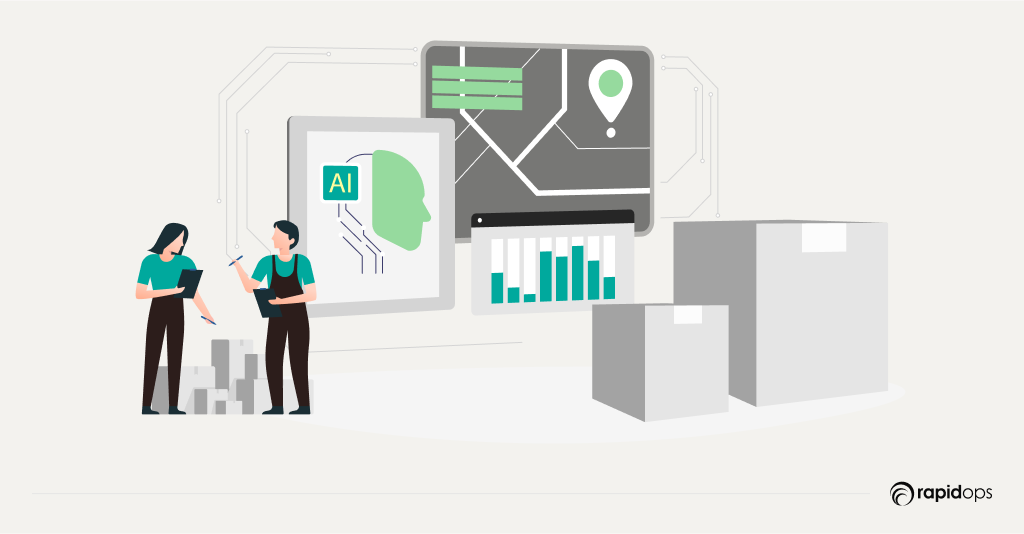
AI enables real-time, intelligent inventory optimization by analyzing sales velocity, demand signals, lead times, and external variables to dynamically allocate stock across locations. Retailers can optimize fulfillment from warehouses, stores, or third-party partners, improving product availability and reducing excess inventory. Machine learning models continuously adjust replenishment strategies, identify slow movers, and forecast returns. This results in improved shelf availability, reduced markdowns, and lower working capital requirements. When integrated with demand forecasting and logistics systems, AI ensures end-to-end inventory visibility and orchestration, helping retailers scale agile, omnichannel fulfillment strategies that meet shifting consumer expectations.
9. Dynamic price optimization
AI-powered dynamic pricing models adjust prices in real time based on demand, competition, inventory levels, seasonality, and customer behavior. These models evaluate price elasticity and revenue impact to recommend optimal prices for products, bundles, or customer segments. Retailers can automate markdowns, personalize discounts, or run flash promotions with precision, maximizing margin without eroding brand value. By leveraging reinforcement learning, AI systems continuously test and refine pricing strategies across various channels. The result: increased conversion rates, improved profitability, and pricing agility in highly competitive and volatile retail environments, especially during peak events or market shifts.
10. AI for labor planning and workforce optimization

AI transforms labor planning by forecasting staffing needs based on store traffic patterns, sales projections, weather, promotions, and historical trends. These models recommend optimal scheduling, shift allocations, and task assignments to ensure operational efficiency and service quality. AI also supports workforce engagement by balancing employee preferences, compliance, and real-time needs. Retailers benefit from reduced overtime, improved productivity, and higher employee satisfaction. As labor becomes a critical lever for customer experience and cost control, AI-driven workforce optimization enables smarter staffing decisions, empowering retailers to align human resources with dynamic customer demand in both stores and fulfillment centers.
Real-world application of AI in the retail industry
Step into a modern retail environment, and you’ll find AI shaping decisions in real time, from which products land on shelves to how promotions shift by location and demand. It’s the unseen force behind precise inventory moves, context-aware offers, and storefronts that adapt to customer behavior without a single manual trigger. A grocer rerouting perishables mid-route, or a luxury brand adjusting displays based on hyperlocal preferences, these aren’t experiments; they’re operational norms. AI isn’t an add-on; it’s becoming the decision layer that quietly drives retail’s most agile responses.
How AI-powered personalization transformed a U.S. grocery retail giant
One of the largest grocery retailers in the U.S., operating over 2,800 stores and serving 11 million customers daily, found itself at a digital crossroads. While its physical scale provided reach, its online experience lacked the intelligence and agility today’s shoppers expect. Product discovery felt generic, repeat engagement was declining, and fulfillment inefficiencies were impacting customer satisfaction. With competition rising and customer behavior rapidly shifting, the brand needed more than incremental change; it needed a digital reinvention.
To meet these challenges head-on, the retailer embraced AI not as a side project, but as a core enabler of its digital commerce strategy. The transformation began with a powerful AI-driven recommendation engine that continuously learned from customer behavior, transaction patterns, and context to provide personalized product suggestions in real-time. This enabled deeply relevant experiences across more than 30 categories, turning browsing into discovery and driving stronger cross-sell and upsell opportunities.
Search was also reimagined. Traditional keyword-based tools have been replaced with natural language processing, enabling customers to express themselves naturally while still finding exactly what they need. This shift significantly reduced zero-result queries, improved product findability, and made shopping faster and more intuitive.
On the operational side, machine learning models optimized inventory planning by analyzing product velocity, regional trends, and seasonal demand. This led to improved stock accuracy and fewer fulfillment gaps, particularly during periods of high demand.
What made the shift remarkable was the speed. In just four weeks, AI was fully deployed across web and mobile, supported by agile teams and scalable data infrastructure. The models continued to improve post-launch, learning from live customer interactions.
The impact was immediate:
- 10% increase in daily orders
- 1.5x boost in customer loyalty
- 5% improvement in order accuracy
- Personalized experiences scaled across 30+ categories
For this grocery leader, AI wasn’t an experiment; it became the engine behind a smarter, faster, more connected customer experience.
How Diamonds Direct leveraged AI to reinvent luxury customer experiences
Diamonds Direct, a leading U.S. jewelry retailer with 22 showrooms and a growing eCommerce footprint, set out to solve a problem common in modern luxury retail: how to offer truly personalized, high-touch experiences at scale across both digital and physical channels.
Despite their strong brand presence, their legacy systems and disconnected customer data made it difficult to understand evolving preferences or deliver consistent engagement. Luxury, by its nature, demands intimacy. But without unified intelligence, personalization remained out of reach.
To change this, Diamonds Direct embraced a strategic AI-led transformation. The journey began with unifying their customer data into a modern CRM, creating a real-time 360° view of each individual, merging in-store visits, digital interactions, purchase history, and marketing engagement. This foundation powered AI models that could anticipate needs and respond in the moment.
From intelligent product recommendations online to predictive search, dynamic merchandising, and context-aware marketing campaigns, every touchpoint became more tailored. In-store, associates were equipped with real-time insights enabling them to deliver highly personalized consultations that mirrored the intelligence of the digital experience. Even back-end teams benefited: AI helped merchandisers anticipate seasonal trends, optimize assortments, and improve inventory decisions, all driven by real-time demand signals.
The impact was unmistakable:
- 40% growth in revenue, driven by smarter engagement and upselling
- 30% increase in customer retention, thanks to hyper-personalized journeys
- 90% improvement in digital performance, with faster load times and deeper on-site engagement
Diamonds Direct’s story shows how AI, when strategically embedded, becomes more than a tool; it becomes the connective tissue of a truly modern luxury experience.
Key considerations before adopting AI in retail
Before adopting AI in retail, leaders must ensure robust data integrity, scalable architecture, and seamless integration across diverse systems. Ethical AI, transparent governance, and regulatory compliance underpin customer trust. Recognizing workforce implications and safeguarding privacy are critical to unlocking AI’s true potential for sustained value and transformation.
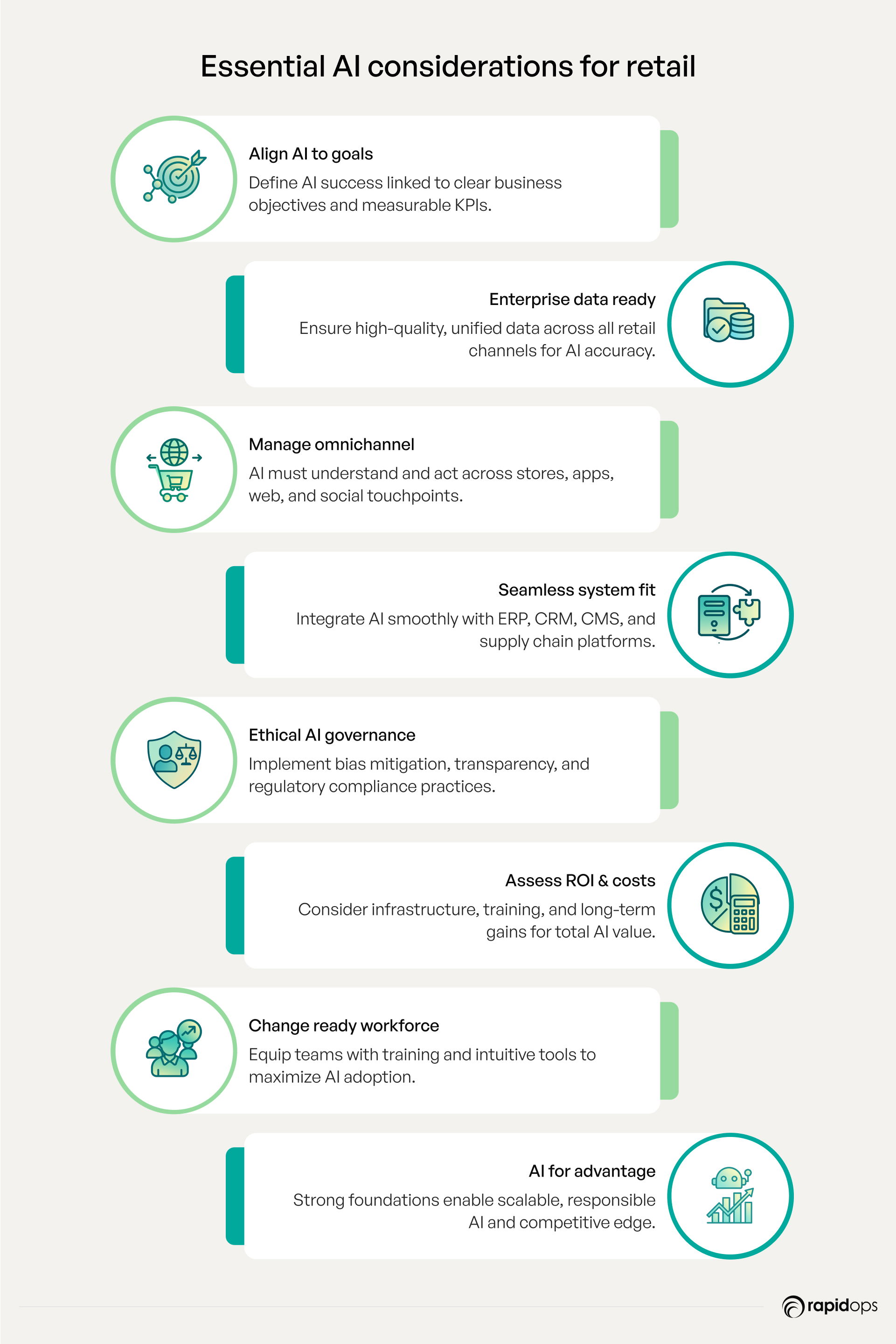
1. Establish clear business alignment
Before investing in AI, organizations must define what success looks like. AI should be directly aligned with strategic business objectives, whether that involves improving demand forecasting, enhancing merchandising precision, optimizing pricing, or elevating the customer experience.
Successful AI initiatives begin with an articulated problem statement and defined KPIs. This alignment ensures AI delivers measurable impact rather than becoming a technology-driven experiment without strategic grounding.
2. Ensure data foundations are enterprise-ready
AI maturity is inextricably linked to data maturity. Retailers must evaluate whether they have access to high-quality, unified, and context-rich data across all channels, including POS systems, loyalty platforms, e-commerce, supply chain, and customer support.
Fragmented, siloed, or inconsistent data architectures severely constrain model accuracy and scalability. Building robust data pipelines and governance structures often via modern data platforms like lakehouses or customer data platforms is a prerequisite for reliable AI outcomes.
3. Account for omnichannel complexity
AI in retail must operate across an increasingly complex customer journey. Shopping behaviors span stores, mobile apps, websites, marketplaces, and social platforms, often in a single transaction cycle.
AI models must be designed to understand and respond to this context in real time. That requires integrating data across physical and digital channels and aligning models with the cadence and nuance of omnichannel customer interactions.
4. Assess integration across enterprise systems
Retailers typically operate in hybrid technology environments with legacy systems, cloud platforms, and third-party integrations. AI tools must seamlessly integrate into this architecture to avoid operational disruption and ensure business continuity.
Evaluation criteria should include interoperability with ERP, CMS, CRM, and supply chain systems. Modular, API-first AI platforms with open architectures often offer greater flexibility and lower integration friction.
5. Embed ethical governance and transparency
As AI influences pricing, recommendations, supply chain decisions, and customer engagement, retailers must ensure models operate responsibly. Ethical AI is not optional; it is central to brand trust, compliance, and long-term viability.
Organizations should embed governance frameworks that ensure transparency, mitigate bias, promote explainability, and ensure regulatory compliance. Internal review processes, third-party audits, and responsible AI practices are essential components of sustainable AI deployment.
6. Evaluate total cost and long-term ROI
AI adoption involves more than licensing costs. Infrastructure, model training, workforce enablement, data management, and ongoing optimization all contribute to the total cost of ownership.
Retailers should develop a detailed business case that considers both near-term gains (e.g., improved conversion rates or reduced stockouts) and long-term impact (e.g., supply chain agility or margin growth). Clear ROI models drive stakeholder alignment and funding commitment.
7. Prepare the organization for change
AI transforms how work gets done, from how marketers build campaigns to how store associates engage with customers. Success depends not only on the technology but on the people and processes surrounding it.
Retailers must invest in training, change management, and operational readiness to ensure a seamless transition. Empowering business users with AI tools that are intuitive and insight-driven can accelerate adoption and unlock broader enterprise value.
AI’s potential in retail is profound, but it demands more than technical implementation. Success depends on enterprise-wide alignment, mature data ecosystems, seamless integration, and a responsible approach to model governance. Retailers that invest in these foundations will be positioned to scale AI with confidence and unlock sustainable competitive advantage.
AI isn’t the future of retail. It’s the new operating system
Throughout this piece, we’ve explored how AI in retail has moved from isolated experimentation to integrated execution, transforming how enterprises engage customers, optimize operations, and unlock growth. From hyper-personalization to autonomous supply chains, the leading retailers of 2025 aren’t just using AI, they’re being redefined by it.
But here’s the deeper truth: The advantage is no longer in knowing what’s possible; it’s in how you execute.
And execution requires more than just tools. It demands experience. Strategy. And a partner who can bridge the gap between AI ambition and real-world retail transformation.
At Rapidops, we’ve spent 16 years helping mid-to-large-scale retailers turn complex business challenges into intelligent, data-powered ecosystems. We’ve built and scaled AI-driven platforms across merchandising, omnichannel engagement, operations, logistics, and customer experience, not just with prototypes, but in production, with measurable impact.
So the question isn’t whether to adopt AI.
It’s whether you’re ready to lead with it before your competitors do. If you’re exploring how to modernize core retail functions, unlock value from your data, or scale intelligent experiences across channels and teams. Schedule a 1:1 session with our AI experts to map out what’s possible and what’s next for your retail business.
Frequently Asked Questions
What’s the expected ROI for AI initiatives in retail?
The ROI of AI in retail comes from tangible improvements in operational efficiency, revenue growth, and customer satisfaction. When applied to areas like pricing optimization, inventory forecasting, and personalization, AI accelerates business performance and decision-making across the value chain. However, achieving sustainable ROI requires aligning AI use cases with strategic goals, ensuring high-quality and accessible data, and embedding change management practices to scale adoption effectively.
How can retailers ensure data privacy and compliance when adopting AI?
Ensuring data privacy requires a robust governance framework built around secure data architectures, role-based access, anonymization techniques, and continuous auditing. Retailers must also comply with global and regional regulations (like GDPR, CCPA) and embed privacy-by-design principles into every AI system. Partnering with vendors who offer transparent, explainable AI solutions is critical to maintaining trust and regulatory alignment.
Where should retailers begin their AI adoption journey?
Retailers should start with high-impact, low-friction use cases where data maturity already exists such as demand forecasting, customer segmentation, or intelligent product recommendations. A phased, business-aligned roadmap that starts with pilots and scales through iterative feedback ensures early wins, builds internal confidence, and supports enterprise-wide transformation.
How is AI transforming the in-store shopping experience?
AI is reshaping the physical store by enabling real-time personalization, intelligent shelf management, predictive restocking, and frictionless checkout. Computer vision, IoT sensors, and conversational AI create responsive environments that adapt to shopper behavior, bridging the gap between digital convenience and physical retail immersion.
Can AI help retailers personalize the customer journey across channels?
Yes, AI enables omnichannel personalization by integrating behavioral, transactional, and contextual data to deliver relevant experiences across web, mobile, in-store, and customer service touchpoints. Techniques such as next-best-action modeling, dynamic promotions, and AI-driven content curation ensure tailored engagement at every stage of the customer journey.
How does AI improve inventory and supply chain management in retail?
AI enhances supply chain agility by enabling demand sensing, dynamic pricing, predictive replenishment, and supplier risk monitoring. Retailers using AI-powered forecasting have reduced stockouts and overstocking while increasing fulfillment speed. By turning real-time data into proactive decisions, AI helps balance cost, service, and sustainability across the supply chain.
What’s the expected ROI for AI initiatives in retail?
The ROI of AI in retail comes from tangible improvements in operational efficiency, revenue growth, and customer satisfaction. When applied to areas like pricing optimization, inventory forecasting, and personalization, AI accelerates business performance and decision-making across the value chain. However, achieving sustainable ROI requires aligning AI use cases with strategic goals, ensuring high-quality and accessible data, and embedding change management practices to scale adoption effectively.
How can retailers ensure data privacy and compliance when adopting AI?
Ensuring data privacy requires a robust governance framework built around secure data architectures, role-based access, anonymization techniques, and continuous auditing. Retailers must also comply with global and regional regulations (like GDPR, CCPA) and embed privacy-by-design principles into every AI system. Partnering with vendors who offer transparent, explainable AI solutions is critical to maintaining trust and regulatory alignment.
Where should retailers begin their AI adoption journey?
Retailers should start with high-impact, low-friction use cases where data maturity already exists such as demand forecasting, customer segmentation, or intelligent product recommendations. A phased, business-aligned roadmap that starts with pilots and scales through iterative feedback ensures early wins, builds internal confidence, and supports enterprise-wide transformation.
How is AI transforming the in-store shopping experience?
AI is reshaping the physical store by enabling real-time personalization, intelligent shelf management, predictive restocking, and frictionless checkout. Computer vision, IoT sensors, and conversational AI create responsive environments that adapt to shopper behavior, bridging the gap between digital convenience and physical retail immersion.
Can AI help retailers personalize the customer journey across channels?
Yes, AI enables omnichannel personalization by integrating behavioral, transactional, and contextual data to deliver relevant experiences across web, mobile, in-store, and customer service touchpoints. Techniques such as next-best-action modeling, dynamic promotions, and AI-driven content curation ensure tailored engagement at every stage of the customer journey.
How does AI improve inventory and supply chain management in retail?
AI enhances supply chain agility by enabling demand sensing, dynamic pricing, predictive replenishment, and supplier risk monitoring. Retailers using AI-powered forecasting have reduced stockouts and overstocking while increasing fulfillment speed. By turning real-time data into proactive decisions, AI helps balance cost, service, and sustainability across the supply chain.

Saptarshi Das
Content Editor
9+ years of expertise in content marketing, SEO, and SERP research. Creates informative, engaging content to achieve marketing goals. Empathetic approach and deep understanding of target audience needs. Expert in SEO optimization for maximum visibility. Your ideal content marketing strategist.
What’s Inside
- What AI in retail looks like in 2025
- Core technologies powering AI in retail
- How retailers are creating tangible business value with AI
- Top 10 AI use cases transforming retail in 2025
- 1. AI-powered product discovery
- 2. Product recommendation
- 3. AI-powered up-selling
- 4. Conversational AI for customer engagement
- 5. Generative AI for product content automation
- 6. Real-time sentiment and experience intelligence
- 7. AI-powered demand forecasting
- 8. Intelligent inventory optimization
- 9. Dynamic price optimization
- 10. AI for labor planning and workforce optimization
- Real-world application of AI in the retail industry
- How AI-powered personalization transformed a U.S. grocery retail giant
- How Diamonds Direct leveraged AI to reinvent luxury customer experiences
- Key considerations before adopting AI in retail
- AI isn’t the future of retail. It’s the new operating system

Let’s build the next big thing!
Share your ideas and vision with us to explore your digital opportunities
Similar Stories
- AI
- 4 Mins
- September 2022

- AI
- 9 Mins
- January 2023


Receive articles like this in your mailbox
Sign up to get weekly insights & inspiration in your inbox.

